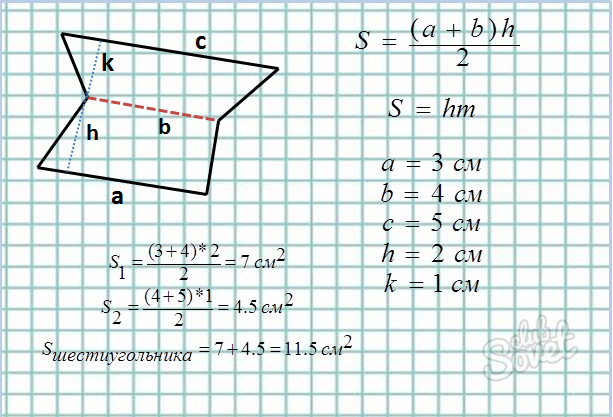How to find the area of a hexagon
A hexagon is a polygon with 6 sides and 6 angles. Depending on whether a hexagon is regular or not, there are several methods for finding its area. We will review everything.
How to find the area of a regular hexagon
Formulas for calculating the area of a regular hexagon - a convex polygon with six identical sides.
Given side length:
- Area formula: S = (3√3*a²)/2
- If the length of the side a is known, then substituting it into the formula, we can easily find the area of the figure.
- Otherwise, the length of the side can be found through the perimeter and apothem.
- If the perimeter is given, then we simply divide it by 6 and get the length of one side. For example, if the perimeter is 24, then the side length will be 24/6 = 4.
- Apothem is a perpendicular drawn from the center to one of the sides. To find the length of one side, we substitute the length of the apothem into the formula a = 2*m/√3. That is, if the apothem m = 2√3, then the length of the side a = 2*2√3/√3 = 4.
Given an apothem:
- Area formula: S = 1/2*p*m, where p is the perimeter, m is the apothem.
- Let us find the perimeter of the hexagon through the apothem. In the previous paragraph, we learned how to find the length of one side through an apothem: a \u003d 2 * m / √3. It remains only to multiply this result by 6. We get the perimeter formula: p \u003d 12 * m / √3.

Given the radius of the circumscribed circle:
- The radius of a circle circumscribed around a regular hexagon is equal to the side of this hexagon.
Area formula: S = (3√3*a²)/2

Given the radius of the inscribed circle:
- Area formula: S = 3√3*r², where r = √3*a/2 (a is one of the sides of the polygon).

How to find the area of an irregular hexagon
Formulas for calculating the area of an irregular hexagon - a polygon whose sides are not equal to each other.
Trapeze method:
- We divide the hexagon into arbitrary trapezoids, calculate the area of each of them and add them up.
- Basic formulas for the area of a trapezoid: S = 1/2*(a + b)*h, where a and b are the bases of the trapezoid, h is the height.
S = h*m, where h is the height, m is the midline.

The coordinates of the vertices of the hexagon are known:
- To begin with, let's write down the coordinates of the points, moreover, placing them not in a chaotic order, but sequentially one after another. For example:
A: (-3, -2)
B: (-1, 4)
C: (6, 1)
D: (3, 10)
E: (-4, 9)
F: (-5, 6) - Next, carefully, multiply the x-coordinate of each point by the y-coordinate of the next point:
-3*4 = -12
-1*1 = -1
6*10 = 60
3*9 = 27
-4*6 = -24
-5*(-2) = 10
Add up the results:
-12 — 1 + 60 + 27 — 24 + 10 = 60
Next, multiply the y-coordinate of each point by the x-coordinate of the next point.
-2*(-1) = 2
4*6 = 24
1*3 = 3
10*(-4) = -40
9*(-5) = -45
6*(-3) = -18
Add up the results:
2 + 24 + 3 — 40 — 45 — 18 = -74
Subtract the second from the first result:
60 -(-74) = 60 + 74 = 134
The resulting number is divided by two:
134/2 = 67
Answer: 67 square units.

- Also, to find the area of a hexagon, you can break it into triangles, squares, rectangles, parallelograms, and so on. Find the areas of its constituent figures and add them up.

So, the methods for finding the area of a hexagon for all occasions have been studied. Now go ahead and apply what you've learned! Good luck!

